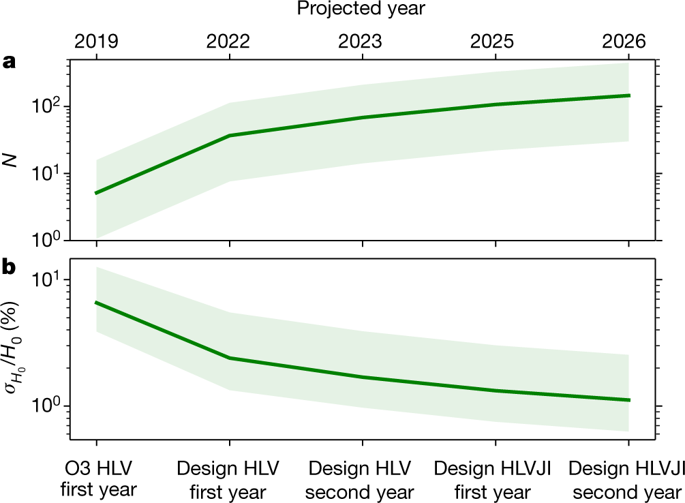Our official English website, www.x-mol.net, welcomes your
feedback! (Note: you will need to create a separate account there.)
A two per cent Hubble constant measurement from standard sirens within five years
Nature ( IF 50.5 ) Pub Date : 2018-10-01 , DOI: 10.1038/s41586-018-0606-0 Hsin-Yu Chen , Maya Fishbach , Daniel E. Holz
Nature ( IF 50.5 ) Pub Date : 2018-10-01 , DOI: 10.1038/s41586-018-0606-0 Hsin-Yu Chen , Maya Fishbach , Daniel E. Holz

|
Gravitational-wave detections provide a novel way to determine the Hubble constant1–3, which is the current rate of expansion of the Universe. This ‘standard siren’ method, with the absolute distance calibration provided by the general theory of relativity, was used to measure the Hubble constant using the gravitational-wave detection of the binary neutron-star merger, GW170817, by the Laser Interferometer Gravitational-Wave Observatory (LIGO) and Virgo4, combined with optical identification of the host galaxy5,6 NGC 4993. This independent measurement is of particular interest given the discrepancy between the value of the Hubble constant determined using type Ia supernovae via the local distance ladder (73.24 ± 1.74 kilometres per second per megaparsec) and the value determined from cosmic microwave background observations (67.4 ± 0.5 kilometres per second per megaparsec): these values differ7,8 by about 3σ. Local distance ladder observations may achieve a precision of one per cent within five years, but at present there are no indications that further observations will substantially reduce the existing discrepancies9. Here we show that additional gravitational-wave detections by LIGO and Virgo can be expected to constrain the Hubble constant to a precision of approximately two per cent within five years and approximately one per cent within a decade. This is because observing gravitational waves from the merger of two neutron stars, together with the identification of a host galaxy, enables a direct measurement of the Hubble constant independent of the systematics associated with other available methods. In addition to clarifying the discrepancy between existing low-redshift (local ladder) and high-redshift (cosmic microwave background) measurements, a precision measurement of the Hubble constant is of crucial value in elucidating the nature of dark energy10,11.Gravitational-wave observations of binary neutron-star mergers will enable precision measurements of the Hubble constant within five years.
中文翻译:

五年内标准警报器的 2% 哈勃常数测量
引力波探测提供了一种确定哈勃常数 1-3 的新方法,它是宇宙当前的膨胀速率。这种具有广义相对论提供的绝对距离校准的“标准警报器”方法用于通过激光干涉仪引力波检测双中子星合并GW170817的引力波来测量哈勃常数天文台 (LIGO) 和 Virgo4,结合对宿主星系 5,6 NGC 4993 的光学识别。鉴于使用 Ia 型超新星通过局部距离阶梯 (73.24 ± 1.74 公里/秒/兆秒差距)和由宇宙微波背景观测确定的值 (67.4 ± 0. 每百万秒差距 5 公里):这些值相差 7,8 约 3σ。本地距离阶梯观测可能在五年内达到 1% 的精度,但目前没有迹象表明进一步的观测会大大减少现有的差异 9。在这里,我们展示了 LIGO 和 Virgo 的额外引力波探测有望将哈勃常数限制在五年内约 2% 和十年内约 1% 的精度。这是因为观察两颗中子星合并产生的引力波,再加上对宿主星系的识别,可以独立于与其他可用方法相关的系统学直接测量哈勃常数。
更新日期:2018-10-01
中文翻译:

五年内标准警报器的 2% 哈勃常数测量
引力波探测提供了一种确定哈勃常数 1-3 的新方法,它是宇宙当前的膨胀速率。这种具有广义相对论提供的绝对距离校准的“标准警报器”方法用于通过激光干涉仪引力波检测双中子星合并GW170817的引力波来测量哈勃常数天文台 (LIGO) 和 Virgo4,结合对宿主星系 5,6 NGC 4993 的光学识别。鉴于使用 Ia 型超新星通过局部距离阶梯 (73.24 ± 1.74 公里/秒/兆秒差距)和由宇宙微波背景观测确定的值 (67.4 ± 0. 每百万秒差距 5 公里):这些值相差 7,8 约 3σ。本地距离阶梯观测可能在五年内达到 1% 的精度,但目前没有迹象表明进一步的观测会大大减少现有的差异 9。在这里,我们展示了 LIGO 和 Virgo 的额外引力波探测有望将哈勃常数限制在五年内约 2% 和十年内约 1% 的精度。这是因为观察两颗中子星合并产生的引力波,再加上对宿主星系的识别,可以独立于与其他可用方法相关的系统学直接测量哈勃常数。











































 京公网安备 11010802027423号
京公网安备 11010802027423号